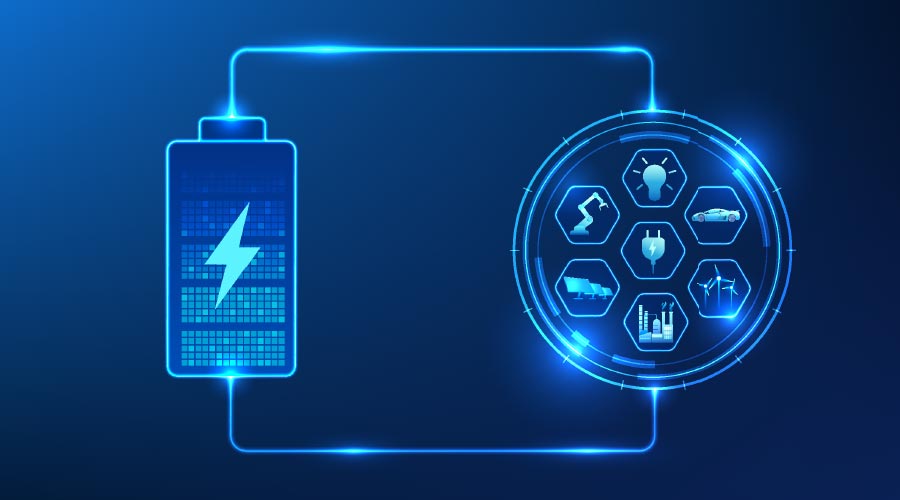
Lithium-ion batteries are having a moment in floor care, and for good reason: Longer run times, faster charging times, and longer life cycles are just some of the advantages driving their adoption in a range of floor machines, from scrubbers to sweepers to vacuum cleaners.
According to battery manufacturers, lead acid batteries and lithium-ion batteries are still the primary technologies being utilized in floor care machines today. And although the upfront cost of lithium-ion batteries can be a deterrent for some, distributors play an important role in educating customers on their long-term benefits and assessing their total cost of ownership.
“There’s been a rapid adoption of lithium among floor care vendors because it’s lighter, better and charges faster, but cost is a big driver,” notes Hiroshi Hasegawa, customer success manager for Delta-Q, Burnaby, BC, Canada. “That’s been the main reason why lithium hasn’t taken over the floor care market.”
Is Lighter Better?
The two most common types of lithium-ion batteries used in cleaning equipment are lithium iron phosphate (LFP) and nickel manganese cobalt (NMC). Hanswouter Poppelier, innovation and product delivery director for Navico Group (parent company of the RELiON brand), shares that LFP is the most used of the two battery types because it is safer and less expensive. Still, distributors should work closely with customers to assess their needs and weigh both the benefits and drawbacks of both chemistries before deciding.
“The choice of battery depends on what the customer wants to achieve,” notes Poppelier. “If they want greater capacity and longer run times without having to charge the battery as often, they can go with LFP. For applications where size and weight are a concern, customers almost always go with NMC because of its weight advantages.”
In fact, lithium-ion batteries in general are lighter compared to their lead acid counterparts — a boon for frontline workers tasked with installing new batteries in floor machines or frequently bearing the weight of equipment, such as backpack vacuums.
“Lithium has the highest energy density, and it’s the lightest,” notes Fred Wehmeyer, senior vice president of engineering, U.S. Battery Mfg. Co., Augusta, Georgia. “If the equipment is handheld, it’s going to use a lithium battery.”
However, a lighter battery may be a disadvantage in larger floor cleaning machines or material handling equipment.
“Lightweight isn’t necessarily an advantage in floor care,” notes Hasegawa. “Floor scrubbers and burnishers require a minimum weight; if they become too light, there isn’t enough downward pressure on the brushes to clean properly. In these cases, having a lithium battery may not be an advantage. And in material handling applications, like pallet lifters and forklifts, you need weight as a counterbalance for the load you’re lifting, so having a lighter battery isn’t an advantage in these cases, either.”
Leading the Charge
One of lithium-ion chemistry’s biggest selling points is its cycle life. In fact, according to Poppelier, it is one of the main drivers for replacing or upgrading cleaning equipment that runs on lead acid batteries.
“Lithium ion is three-to-five times more expensive than lead acid, but the number of cycles is much greater,” he says. “Some lead acid batteries have 50 cycles, and the more advanced ones have 600 cycles. A lithium battery can reach up to 3,500 cycles. If you need to replace a lead acid battery every two years, you can replace a lithium battery every six to eight years. That’s a massive difference.”
Additionally, a lithium battery’s power is more consistent than a lead acid battery during discharge.
“When you discharge a lead acid battery, the equipment starts to slow down over time,” notes Hasegawa. “For instance, a vacuum will start to lose suction power because it’s not getting the voltage it needs from the battery pack. A lithium battery can maintain that high voltage throughout.”
And when it comes to charging batteries, lithium-ion is a good candidate for opportunity charging; that is, charging the battery for short periods of time throughout the day. There is only one caveat: Custodians must ensure that they use the right charger.
“Lithium-ion is very sensitive to the right charger,” says Poppelier. “If the current is too high when charging your battery, it will deplete the number of charge cycles. Make sure customers understand that they must use the proper charger and adhere to the charging instructions from the manufacturer.”
In addition to requiring the right charger, lithium-ion batteries require the right ambient temperature while recharging or discharging. Hasegawa recalls an occasion when an end user was having trouble charging a floor machine because the air temperature in the warehouse was 40 degrees. On another occasion, an end user complained that the charger was overheating the batteries.
“When I went to look at his facility, I found he was charging his burnisher in a boiler room, and the average temperature in the room was 85 degrees Fahrenheit,” he says. “All we had to do was move the machine to another room. So, we need to be careful: When someone says, ‘room temperature,’ it can mean different things to different people.”
Essential Safety Tips for Lithium Batteries

 Celebrating BSCAI's 60th Anniversary eBook
Celebrating BSCAI's 60th Anniversary eBook The Down and Dirty on Cleaning in Virus Season
The Down and Dirty on Cleaning in Virus Season How Surfactant Use is Expanding in Commercial Cleaning
How Surfactant Use is Expanding in Commercial Cleaning